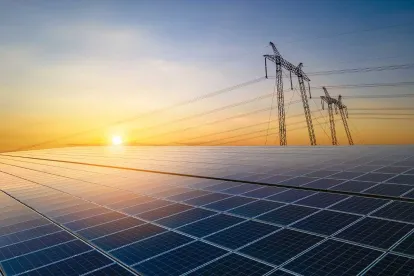On August 11, 2022, Massachusetts Governor Charlie Baker signed into law An Act driving climate policy forward. After months of heavy legislative activity involving a wide range of stakeholders in the clean energy and technology industries, the Massachusetts legislature combined what was a bill that we reported on earlier focused on expanding offshore wind energy and transmission development with another that covered a wide range of climate policies. The resulting omnibus bill involves clean energy workforce and economic development, offshore wind procurement, potential large scale procurement of energy storage, regional coordination of clean energy development, changes to the treatment of other clean energy resources, further adoption of electric vehicles, energy efficiency and building electrification, the transition away from the use of natural gas, and modernization of the electric distribution system to enable increased adoption of renewable energy, energy storage, and vehicle and building electrification. The Governor had returned the bill with amendments, leaving the Legislature only the last weekend of July to consider further amendments by the end of the regular session.
Offshore Wind and Economic Development
This year’s bill expands offshore wind procurement under Section 83C to 5,600 MW from the 4,000 MW amount last set by St. 2021, Ch. 8, An Act Creating a Next-Generation Roadmap for Massachusetts Climate Policy. Notably, it removes the price cap, which required subsequent procurements to be priced lower than the previous procurement.
As compared to previous enactments involving offshore wind and other clean energy procurements, this bill places significantly more emphasis on workforce and economic development. It adds additional procurement preferences for bids that promote development of the domestic offshore wind industry supply chain, mitigation of environmental and socioeconomic impacts, organized labor agreements, various low-income community and diversity, equity, and inclusion goals, support for municipal and other customer aggregations, the use of mid- and long-duration energy storage, and other resources able to guarantee “firm energy delivery,” i.e. guaranteed availability to supply during multi-day grid contingencies.
The bill reflects the legislature’s heightened sensitivity to the impacts of the growth of offshore wind energy development after pushback in the wake of the most recent procurements. It requires developers to submit best management practices and plans to minimize and mitigate impacts on marine wildlife, habitats, ecosystems, and existing water-dependent uses, such as commercial and recreational fishing. It also creates a commercial fisheries commission to promote the sustainability of the commercial fishing industry and create dialog between stakeholders of the fishing industry and the marine-based energy and transmission industry.
The bill places the Massachusetts Clean Energy Center (MassCEC) at the focal point of state initiatives on offshore wind research, development, and training. It creates an offshore wind industry investment program. For the next ten years, MassCEC may authorize tax incentives for certified offshore wind companies that propose economic development plans. MassCEC may also make funding available from the Offshore Wind Industry Investment Trust Fund to support supply chain development, research, manufacturing facilities, interconnection studies, port development, workforce development, securing federal cost-share funding, and planning, technical, and program support to enable municipal or other aggregations to enter into long-term contracts to purchase electricity from offshore wind developers. The bill also creates a separate Clean Energy Investment Fund administered by MassCEC for similar purposes but supporting clean energy and technology industry development generally.
Energy Storage
The bill requires electric distribution companies to file tariffs addressing operational parameters to apply to distribution interconnected energy storage systems and design rates to recover costs not recouped through interconnection upgrade and other direct charges paid by the project sponsor.
Within 9 months after the effective date of the act, the Department of Energy Resources (DOER) is required to recommend mid-duration and long-duration energy storage system deployment targets for inclusion in the Commonwealth’s climate roadmap plans. The bill also requires DOER and MassCEC to prepare a report by December 31, 2023, on various matters regarding financing, incentives, and deployment of mid-duration and long-duration energy storage, as well as the necessity, costs, and benefits of requiring solicitation of up to 4,800 gigawatt-hours of storage of energy from renewable generation. If DOER finds it beneficial, it “shall” require electric distribution companies to solicit and procure energy storage in accordance with the study recommendations.
Regional Coordination
The bill authorizes DOER to “coordinate with one or more New England states undertaking competitive solicitations” for clean energy generation, transmission, or capacity projects that are Class I RPS eligible and have a commercial operation date after January 1, 2022, and determine, by December 31, 2022, whether the projects meet certain criteria. If DOER makes such a determination, the electric distribution companies are required to enter into cost-effective long-term contracts to be submitted for review and approval by the Department of Public Utilities. This procurement has not been enacted under the “Section 83” framework. Given the short timeframe, DOER would likely need to “piggyback” onto existing solicitations by other New England states. As of this writing, Maine has an outstanding solicitation for transmission and generation to develop renewable projects in Northern Maine, and Rhode Island enacted legislation on July 6, 2022 that requires Rhode Island Energy to issue a procurement for 600 to 1,000 MW of offshore wind by October 15, 2022.
On a more relaxed timeframe, the Executive Office of Energy and Environmental Affairs (EEA) is required to investigate and report by March 1, 2023, on “the advantages and disadvantages of using or participating in regional or multi-state market-based mechanisms, structures, systems or competitive solicitations to facilitate the development of clean energy generation resources.” If the EEA finds regional or multi-state market-based mechanisms, structures, systems or competitive solicitations to be “beneficial to the commonwealth,” EEA and DOER are authorized to adopt regulations implementing them.
Other Clean Energy
Currently, renewable energy generating resources on agricultural or horticultural land may only generate for the use of the land and farm upon which it is located, which may include contiguous or non-contiguous land owned or leased by the owner. This bill provides that land may be used to site a renewable energy generating source that qualifies for a DOER solar incentive program for agricultural or horticultural sectors and remain classified as used for agricultural or horticultural use for tax purposes if the renewable energy generating source does not impede that use of the land.
The bill modifies a hole in the exemption from net metering caps. In order to be exempt from net metering caps, the nameplate capacity of a Class I net metering facility previously had to be 10 kW or less on a single-phase circuit, or 25 kW or less on a three-phase circuit. The amendment exempts all Class I net metering facilities with a nameplate capacity equal to or less than 25 kW.
Over the years, various exemptions to net metering regulations have been litigated before the Department of Public Utilities (DPU). This amendment removes limitations to permit any number of solar net metering facilities on the same parcel to receive net metering credits where (i) the net metering facilities are on a government-owned parcel up to an aggregate limit of 10 MW; (ii) the net metering facilities are on a parcel where all buildings are low or moderate income housing; (iii) each net metering facility is on a separate rooftop up to an aggregate limit of 2 MW on the single parcel; (iv) each net metering facility is on the same rooftop, each connected to a customer behind the meter, up to an aggregate of 10 MW; or (v) additional net metering facilities are installed not less than a year before the previous installed facility up to an aggregate of 2 MW.
Electric Vehicles and Charging Infrastructure
The bill takes a number of steps to advance increased adoption of electric vehicles. The bill codifies the electric vehicle rebate program currently funded by DOER by creating an Electric Vehicle Adoption Trust Fund and increasing the rebate levels and purchase price limit. The bill also establishes an intergovernmental coordinating council to implement an electric vehicle charging infrastructure deployment plan and creates a Charging Infrastructure Deployment Fund.
The electric vehicle supply equipment industry scored a win in its efforts to obtain EV-ready building code regulations. Previously, the Board of Building Regulations and Standards was permitted to include requirements for EV charging in amendments to the state building code and the state electric code. The bill changes a “may” to a “shall,” and BBRS is now required to amend to state building code and the state electric code to include EV charging requirements.
The sale in Massachusetts of a new passenger car or light duty truck that is not a zero emissions vehicle will be unlawful by January 1, 2035, once EEA certifies that the same rule is in effect in California. If California adopts the rule earlier, the Department of Environmental Protection may adopt the same regulations.
Although some ridesharing services already offer “green” ride options, the bill requires the DPU’s Transportation Network Company Division to establish requirements for vehicle electrification and greenhouse gas (GHG) emissions requirements to the extent permitted by federal law. (Massachusetts cannot regulate vehicle “emissions” where the regulation differs from California standards or federal standards). If vehicle electrification alone would be sufficient to meet EEA’s GHG goals, TNC Division may establish rideshare vehicle electrification regulations without establishing separate requirements for GHG emissions. The TNC Division “shall” promulgate regulations by October 1, 2023 and implement them by April 1, 2024.
Energy Efficiency and Building Electrification
The bill makes changes to the use of commercial property assessed clean energy (PACE) financing. The construction of a gas distribution line extension no longer qualifies as a qualifying commercial energy improvement. Further, the bill removes cost-effectiveness determination and replaces it with comparison of cost savings to “required energy code requirements at the time of project permitting” or whether the project “meets another nationally-recognized building standard for energy performance” deemed appropriate by DOER.
The bill creates a large building energy reporting requirement. “Large” buildings are those with at least 20,000 square feet of gross floor area, and “energy” includes electricity, natural gas, steam, hot or chilled water, heating oil, propane or other products designated by the department that are used for heating, cooling, lighting, industrial and manufacturing processes, water heating, cooking, clothes drying or other purposes. Electric, gas, and steam utilities will be required annually to report energy use by each large building with an account, and large building owners will be required to report all other energy use. This information will be published by DOER on a website on a building-specific basis. DOER is required to promulgate regulations to implement this by July 1, 2025.
Beginning with the 2025 – 2027 energy efficiency plans, utilities may include energy efficiency programs that “combine efficiency and electrification with renewable generation and storage.”
Several municipalities have sought unsuccessfully to ban new building construction or major renovation, but this has been in conflict with state law. Last year’s Act Creating a Next-Generation Roadmap for Massachusetts Climate Policy required DOER to promulgate a municipal opt-in specialized stretch energy code that includes net-zero building performance standards, but the current version of the draft code still allows for installation of fossil fuel infrastructure under certain conditions. This bill requires DOER to establish a demonstration program allowing ten municipalities to adopt general or zoning ordinances or by-laws restricting or prohibiting new building construction or major renovation projects that are not fossil fuel-free.
The Future of Gas
In 2020, the DPU opened an investigation in docket D.P.U. 20-80 into the planning and operations of local gas distribution companies (LDC) in light of the Commonwealth’s GHG reduction targets. The LDCs submitted operating plans that proposed to continue upgrading their gas infrastructure under their Gas System Enhancement Plans and pursue electrification strategies, such as hybrid heat pump systems and networked geothermal heating and cooling, as well as decarbonized gas strategies, such as using production certified gas with lower upstream and midstream emissions, renewable natural gas, and hydrogen.
The new legislation requires DPU to conduct an adjudicatory hearing prior to approving such plans. It also requires DPU to consider the impact of rate design and remove impediments to “replacement of gas infrastructure with utility-scale non-emitting renewable thermal energy infrastructure.” As defined, “utility-scale non-emitting renewable thermal energy infrastructure” is “distribution infrastructure that supplies heating, or heating and cooling, from fuel sources whose combustion does not emit greenhouse gases,” and may include, but is not limited to a networked geothermal system.
Electric Sector Modernization Plan
The legislation requires each electric distribution company to develop a detailed electric sector modernization plan to improve grid reliability, enable increased adoption of renewable energy, distributed energy resources, energy storage, and building and transportation electrification. The plans will cover three planning horizons: 5-year, 10-year, and 2050. The plan development and approval process will be similar to the process for developing energy efficiency plans. Plans will be submitted to Grid Modernization Advisory Council for consideration prior to filing with DPU. To be approved by DPU, the plan shall provide “net benefits for customers” and meet enumerated criteria.
Conclusion
Clients will need to act on these energy and climate initiatives as they move into the regulatory stage under a new governor to be elected this November and new agency heads. We can help with the next steps. At the same time, the next legislative session starts in January with major energy and climate legislation likely to be taken up in another round.






 />i
/>i
